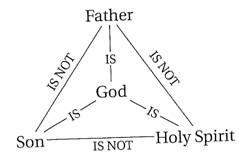Wayne Grudem’s Systematic Theology defines the Trinity as follows: “God eternally exists as three persons, Father, Son, and Holy Spirit, and each person is fully God, and there is one God” (p. 226).
Broken down, this amounts to three propositions:
* God is three persons.
* Each person is fully God.
* There is one God.
In addition, it’s helpful to elaborate on the fact that when we say “God is three persons,” we mean that he is not just one person, and that the persons of the Trinity are not to be confused. So we can also say:
* The Father is God.
* The Son is God.
* The Holy Spirit is God.
* The Father is not the Holy Spirit, and the Holy Spirit is not the Father.
* The Holy Spirit is not the Son, and the Son is not the Holy Spirit.
* The Son is not the Father, and the Father is not the Son.
If your head is starting to spin—then perhaps this little diagram can help give you a snapshot of what we’ve been saying:
Theologians have typically described God as being of “one essence” but “three persons.” But what exactly do we mean by “essence” and “person”? In its simplest terms, essence answers the question, “What are you?” Person answers the question, “Who are you?”
So when we say that the Trinity entails “one essence” (God) and “three persons” (Father, Son, and Spirit), we are saying that the Trinity has one What and three Who’s. We can draw this as follows:
Friday, October 12, 2007
the trinity
A guy in our small group was recently asking about the Trinity and 'coincidentally' Justin Taylor just posted a simple yet excellent article on the topic.
Subscribe to:
Post Comments (Atom)



1 comment:
God is either three persons or one person through three manifestations.
I subscribe to the orthodox view of the Trinity but claim no complete insight and as long as equal divinity is ascribed to the Father, Son, and Holy Spirit I am not alarmed but discussion.
Post a Comment